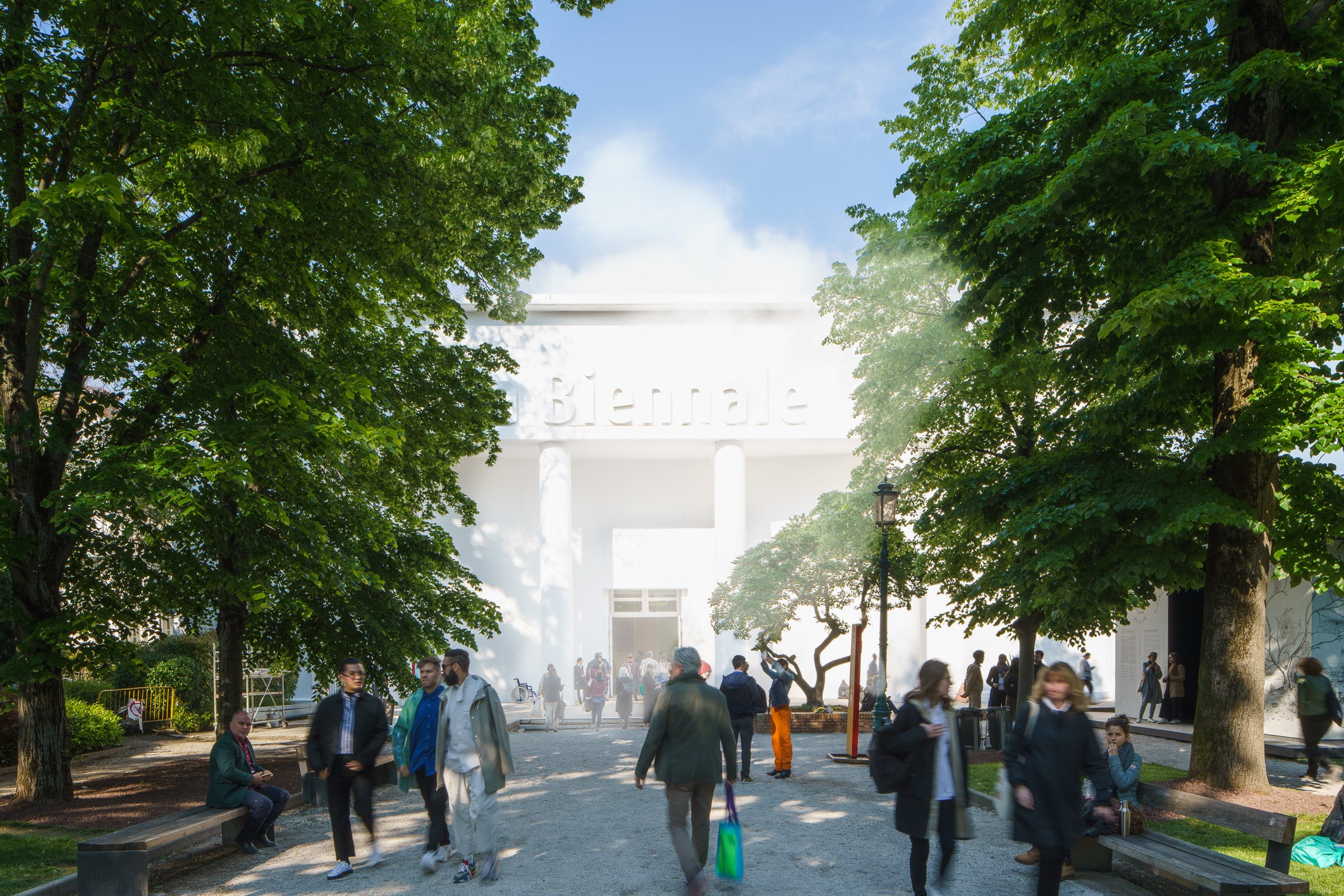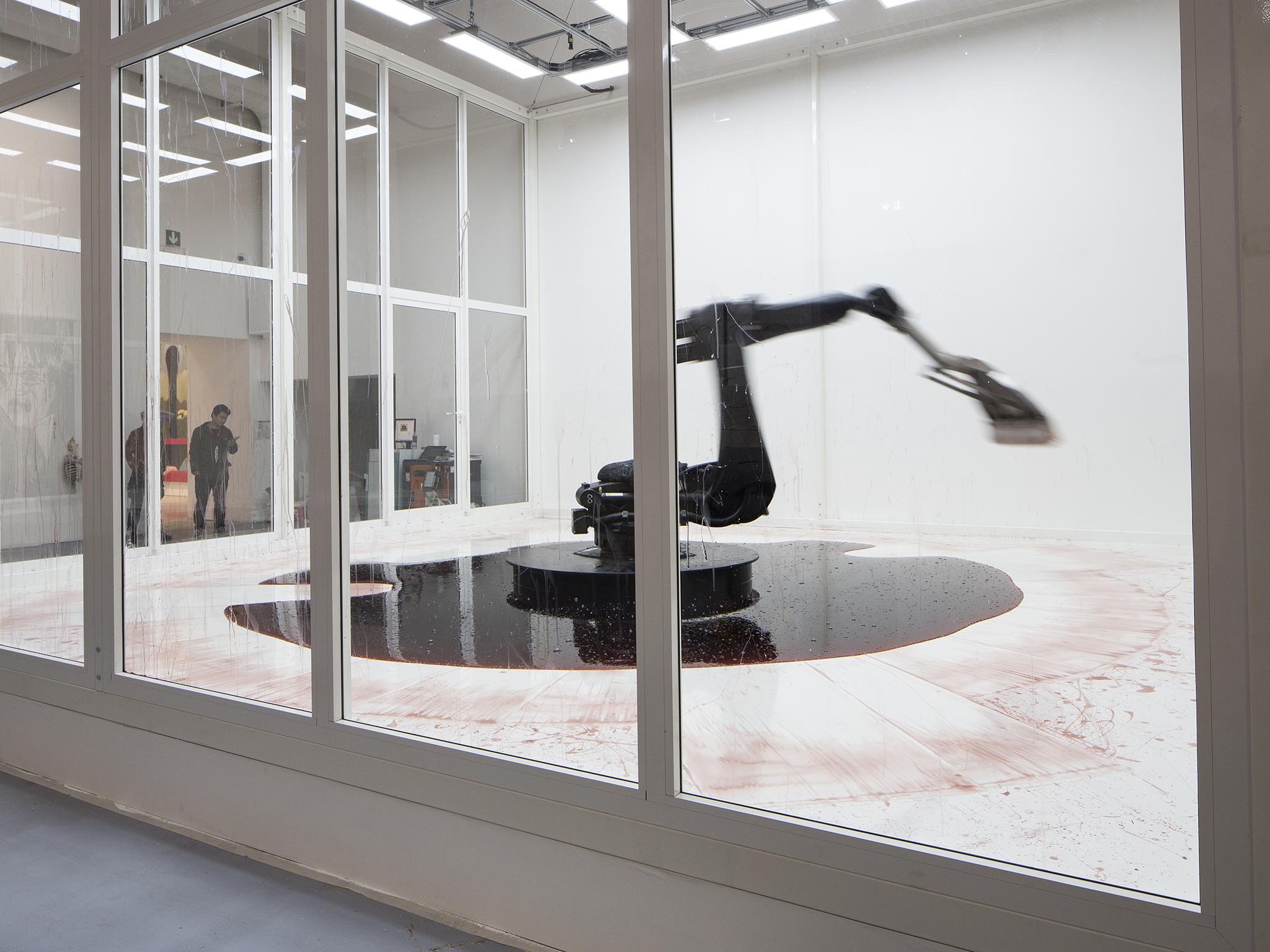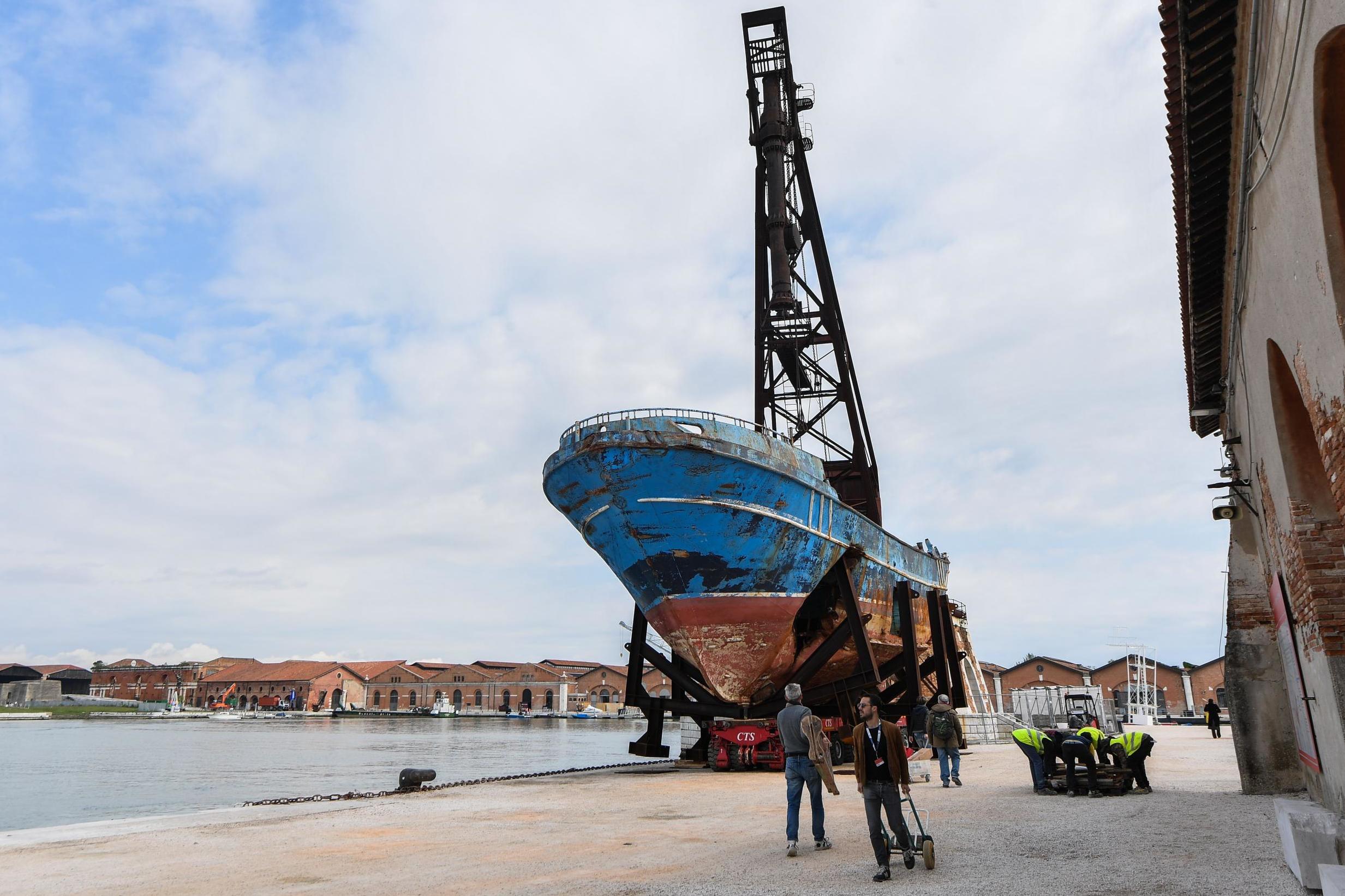The Venice Biennale: The artistic equivalent of Top of the Pops
The 58th Venice Biennale includes some of the best global artists under 40. But, says Jason Farago, it is a lukewarm, nebulous edition that doesn’t know what it wants

Your support helps us to tell the story
From reproductive rights to climate change to Big Tech, The Independent is on the ground when the story is developing. Whether it's investigating the financials of Elon Musk's pro-Trump PAC or producing our latest documentary, 'The A Word', which shines a light on the American women fighting for reproductive rights, we know how important it is to parse out the facts from the messaging.
At such a critical moment in US history, we need reporters on the ground. Your donation allows us to keep sending journalists to speak to both sides of the story.
The Independent is trusted by Americans across the entire political spectrum. And unlike many other quality news outlets, we choose not to lock Americans out of our reporting and analysis with paywalls. We believe quality journalism should be available to everyone, paid for by those who can afford it.
Your support makes all the difference.Every other spring I come to this waterlogged city, take the vaporetto waterbus to a garden on its eastern edge and walk into a large white building. This year, I had some trouble making it out. Here in the Giardini della Biennale, the principal site of the world’s most enduring exhibition of contemporary art, Italian artist Lara Favaretto has enveloped the white central pavilion in a dense cloud of artificial fog. The words La Biennale, above the colonnade, fade into formlessness.
Let Favaretto’s cloud stand as the emblem for this diffuse biennial, which brings together many of the biggest names in art today but never quite coheres. Ralph Rugoff, the London-based American curator, has fashioned a show that aims to take stock of our foggy present, when shared narratives have collapsed and we struggle to find our bearings. His show is handsomely installed in some places, and elsewhere weirdly indifferent to display. It’s up to the minute but also safe and detached. The 58th Venice Biennale is a lukewarm, nebulous edition, and I wish I knew what it wanted.
It’s a young biennial, and includes some of today’s greatest talents under 40, including Neil Beloufa, a young French-Algerian artist; Njideka Akunyili Crosby, the Nigerian-born painter based in Los Angeles; Ed Atkins, the British video artist; and Kemang Wa Lehulere, a rising star of South Africa. For the first time in my memory, every artist here is alive. Rugoff has forsworn any reanimations of neglected older figures, whom curators often use to shape a biennial’s plan of attack.
But the 79 artists and collectives here are almost all known quantities. A dismaying percentage of the art has already been shown in New York, Los Angeles, London or Berlin, and the globalism of the biennial’s last two editions has been jettisoned for western institutional pre-approval. I walked out having discovered precisely two exciting artists I didn’t know: Handiwirman Saputra, an Indonesian whose disjunctive sculptures – including off-kilter columns and pink loops that are like giant rubber bands – enact surprising contrasts of scale, shape and surface; and the promising young Indian photographer Soham Gupta, who shoots empathetic, night-swallowed portraits of those living on the margins of Kolkata.

A biennial jammed with the art world’s present winners could work, I guess, if it organised and analysed them for new audiences – many, after all, will be discovering them for the first time. That hasn’t happened in this light-touch exhibition. It unfolds as a disconnected cascade of objects and images, in galleries sometimes sloppily hung. If Venice’s last two editions made strident claims on the path forward for art (for better in 2015, for worse in 2017), the 2019 Biennale comes across as the artistic equivalent of Top of the Pops: a passive rundown of received tastes, dominated by the United States and Britain.
The conceit of Rugoff’s show – and it’s a good one on paper – is to have shrunk the number of participants and asked each to contribute at least two works, which appear in two rhyming shows in two different locations. At the larger of them, the Arsenale (Venice’s former naval yard), he has devised a system of plywood walls that avoids the rat-maze feel of some previous editions. Large installations, including an engrossing effort from the Los Angeles-based artist Kaari Upson that probes the psychological pressures of housing through urethane casts of furniture and cuckoo video performances, have ample breathing room.
But in the Giardini’s befogged central pavilion, the same 79 artists occupy less than a third of the space. Too much art fills too few galleries, and the density forces Rugoff into juxtapositions that come across as cluttered and frivolous.
An excellent large sculpture by the Berlin-based Nairy Baghramian – uniting precariously balanced, biomorphic slabs of aluminum and wax – has been shunted into an attic with a half-ton block of marble brought by the inventive activist Jimmie Durham, with far too many unrelated paintings. It comes across as a room of leftovers. Julie Mehretu, Henry Taylor and George Condo, three American artists working in very different idioms, have brought challenging works that deserved proper space for contemplation and shouldn’t have to compete against one another this way. (They get a bit more room in the Arsenale.)

In some cases, the invitation to show in two venues has let artists take a risk on something new. Atkins, in the Arsenale, presents another gripping installation centred on his digitally rendered videos, in which waxy computer-generated bodies fret, wail, panic and disassemble. Scattered through the Giardini are surprising gouaches of human hands and feet, each of which cradles a tarantula with Atkins’ head grafted onto its body. I found them iffily drawn, but I appreciate the risk he took in showing them.
Avery Singer, an intriguing New York-based painter, has taken a welcome risk here, too. In the Giardini she shows her better-known abstractions prepared with three-dimensional modelling software. But she really delivers in the Arsenale with a new, frank, full-length self-portrait in which she appears to trace patterns on a fogged-up shower door. It made me gasp, then scratch my head, then thrill to its marriage of high-modernist gestures and private doodles.
With more A-side/B-side surprises like that this show might have been a success. Yet the Arsenale and the Giardini have more in common than they should. Wa Lehulere appears with two evocative, but quite similar, installations that probe the inequities of South African education. Why not show his beautiful drawings in one venue instead? And I didn’t need to see even one crazed kinetic sculpture by the grindingly obvious Chinese artists Sun Yuan and Peng Yu; I certainly didn’t need to see two. (If shock was the aim, at least contrast one robot with the couple’s Dogs That Cannot Touch Each Other, their distressing video censored two years ago at the Guggenheim Museum in New York.)
You could also cynically read the double format as an insurance policy, for at this biennale, an artist only needs a 50 per cent hit rate to be called a success. Consider Arthur Jafa, the American filmmaker who won the Golden Lion this year on the strength of his 50-minute The White Album, shown in the Giardini. This commanding achievement (previously shown at the Berkeley Art Museum and Pacific Film Archive) splices reams of found footage of white Americans showing off guns and screaming like crazy people with tenderer images of Jafa’s white friends. It makes use of the same meticulous music cues and on-the-beat editing of his breakthrough video Love Is the Message, the Message Is Death, and exceeds that video in its marriage of political anger and personal vulnerability that ought to horrify a majority-white art audience.

While The White Album alone merited Jafa the Golden Lion, his contribution at the Arsenale was large chain-choked tires (previously shown at Gavin Brown’s Enterprise in New York) that solidified American racism into literally leaden symbols.
Saving the day is the terrifically smart Canadian artist Stan Douglas, whose video installation Doppelgänger uses two projectors, on either side of a translucent central screen, to narrate a tale of quantum mechanics and split personalities. An astronaut is teleported to a spacecraft, but something goes wrong along the way; she gets copied, and her colleagues back on Earth panic that each astronaut may be an alien twin of the other. (The plot wittily hinges on a phrase that reads differently depending on where you’re sitting: the Marxian LIVE REIFIED TIME or, in reverse, the satanic EMIT DEIFIER EVIL.)
Christoph Buchel, the Swiss maximalist, has brought to the Arsenale the wreckage of a small boat that capsized in the Mediterranean in 2015, drowning at least 800 African migrants. The boat sits dry-docked by the water, guarded by a police officer. Staring up at this death trap made me feel powerless and ready to abandon art for a new career in migration law. Even contemplating its force as an artwork feels indecent.
Matters of belonging and borders animate many artists in this year’s national pavilions – organised separately from Rugoff’s show – starting with Martin Puryear, who has done credit to the United States with a conscientious, quietly moving display of eight mostly new sculptures. His meticulously crafted works of marble, pine, hemlock and steel are subtly inflected with themes of liberty and its lack, above all in his A Column for Sally Hemings, a fluted marble bollard topped by an iron shackle.
The French and German pavilions take diametrically opposed approaches to the question of representing a nation. For Germany, Natascha Sadr Haghighian (working under a pseudonym, and pathetically appearing in public with a papier-mache rock over her head) has blasted the Nazi-era pavilion and, with borders on her mind, sprayed a new massive internal dam of concrete.

It comes across as the safest and blandest sort of performed “antagonism” and it looks especially feeble in the shadow of Laure Prouvost, whose pavilion centres on a thrilling video of Frenchmen, migrants and animals all on the move together, forming a new community as they charge southeast from Paris to Venice. Its dreamlike nature never dips into hippiedom or mysticism, and offers a prime lesson for young artists: less astrology, more democracy!
Arching over the Biennale is the immense achievement of the Lithuanian pavilion, where Rugile Barzdziukaite, Vaiva Grainyte and Lina Lapelyte are presenting the opera Sun & Sea (Marina), in which a cast of 20 sings live in English on an artificial beach. (If you visit this year, ensure you are in Venice over a Saturday; it’s being performed only once a week.) This balmiest of environmental elegies, deservedly netting the Golden Lion for best national presentation, translates the bizarreries of climate change as a dulcet chorale, and for days after seeing it, I found myself humming a passage in which a bather blithely trills that last Christmas “there was no frost, no snow / It felt like it could be Easter!”
The end of the world, these Lithuanians propose, may hit us as gently as a pop song. That may also be what Rugoff was going for when he titled this exhibition May You Live In Interesting Times. The apocryphal Chinese curse points to the hazards of what appears benign, although, as he will know from his long years in London, the word “interesting,” delivered with a raised eyebrow, is also a British euphemism for “strange”, “unexpected” or “bad”.
This is an interesting biennial.
The Venice Biennale runs until 24 November
Join our commenting forum
Join thought-provoking conversations, follow other Independent readers and see their replies
Comments